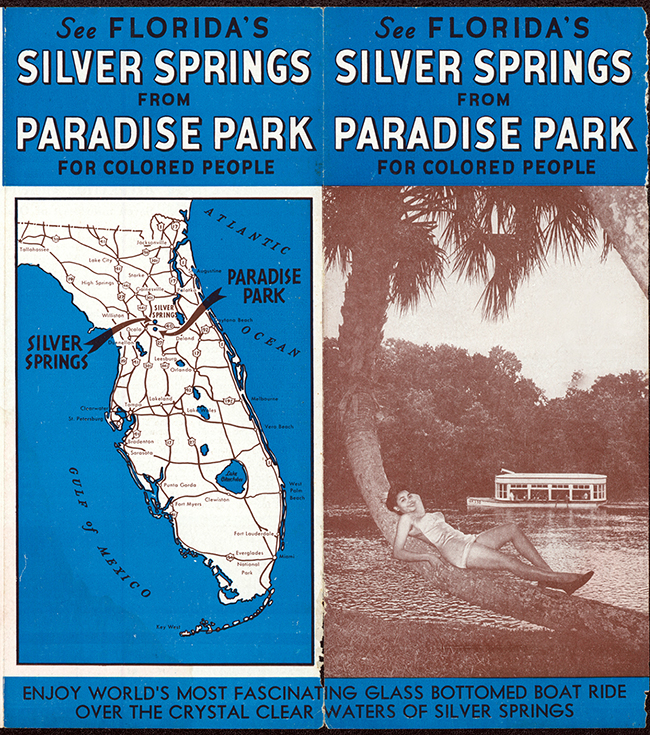Silver Springs: Yesterday and today
A former swimsuit model chats up Silver Springs’ mid-20th century heyday — plus a look at the park’s segregation years and present-day efforts to preserve a beloved patch of Old Florida paradise.
A former swimsuit model upstaged the ancient artifacts on display in the fourth-grade classroom of the Silver River Museum & Environmental Education Center last Saturday.
In the pictures and postcards spread out across tables in the Silver Springs State Park classroom, a fresh-faced blonde posed on land and underwater in Marion County’s famous patch of Old Florida paradise.
The model, Betty Haskins Kutz, known in the photos as Betty Frazee, paid a visit five decades later to the Friends of Silver Springs State Park’s monthly meeting to share memories of her brief time in the limelight, representing the park when it was a popular tourist attraction. She attended the meeting with her daughter, Jana Haskins Faulkner. Both are new members of the friends’ group.
Haskins Kutz reminisced about the park during its roadside-attraction heyday in the mid-20th century, when the Silver Springs attraction was the go-to for touristy fun in Florida and a decade before Walt Disney changed the game and detoured families to Orlando.
“It was in the olden days,” joked Haskins Kutz, “I started as a teenager, in 1957. A lot of people asked me how I got the job, and I was just lucky, I guess.”
As head majorette at Reddick High School (now North Marion High School), Haskins Kutz twirled a baton and danced with the high school band and choreographed numbers. When the band was invited to perform at the park with all the county schools, the wide-eyed performer dazzled with her routine and caught the attention of the park’s publicity director, William Blue Ray, who was known for bringing Hollywood celebrities and the TV show “Sea Hunt” to the park, among other TV and movie celebs.
The then 17-year-old model got consent from her parents to pose for pictures at the park. As “Miss Silver Springs,” she won the Miss Lake Weir contest that year. That contest was one of her many prize-winning competitions, including Miss Florida in Sarasota, for which she was second runner-up in 1958 and won a small scholarship to continue her piano lessons.
Along with modeling and appearing in the odd movie or TV scene, Haskins Kutz and her cohorts helped with clerical tasks in the park’s publicity department.
“We were well-trained secretaries out of Reddick,” Haskins Kutz said. “We had a wonderful teacher who taught us some great skills. We had Typing I and Typing II, and we had shorthand. So, when we were not outside or in the water, we were upstairs in the main offices.”
Haskins Kutz also talked about her days representing Jantzen bathing suits. She toured in a wagon, appeared on “The Tonight Show” with Buddy Hackett, posed in snow skis in Vermont and got to meet celebrities such as “Sea Hunt” star Lloyd Bridges and swimmer-movie star Esther Williams, who visited the park to pose for a publicity shoot.
“I did a layout in ‘McCall’s,’ which was a big magazine back then for women, and they did an article on underwater exercises,” Haskins Kutz shared.
“Oh, geez, like we needed to exercise at 17 and 18!” she added with a laugh.
Challenges and roles that typical teens don’t get the opportunity to take on highlighted the modeling gigs at Silver Springs. Haskins Kutz filled in as a stunt mermaid and wore a red wig in the Jerry Lewis film, “Don’t Give Up the Ship” (1959). She and the other girls had to learn to hold their breath and pose cheerfully underwater, subtly anchoring themselves by gripping underwater rocks or lodging their foot in a crevice.
Speaking of near-suffocating stunts— Haskins Kutz had to perform in a “Sea Hunt” scene that had her locked in a trunk at the bottom of the spring in an episode aptly titled “The Girl in the Trunk.” In a conversation later, her boss, Ray, joked that they almost killed her.
The aquatic beauty even wrestled an alligator once as a stunt double in an obscure action-adventure film, “The Wild Women of Wongo” (1958).
“Herpetologist Ross Allen, who was a big part of the springs then, gave me a lesson on wrestling an alligator,” Haskins Kutz recalled. “They actually put a pin in his mouth, but his claws and his tail were still active. So, I mainly had to just roll around with the gator … and, yes, I was still in my swimsuit.”
She also worked with Ricou Browning, the actor who played the creature in “The Creature from the Black Lagoon. Some film scenes were shot at Silver Springs, with the underwater shots filmed at Wakulla Springs near Tallahassee.
“He had worked underwater long before I did,” she explained. “So, they (he and famed photographer Bruce Mozert) taught me how to scuba dive, how to hose breathe and how to dive deep. We worked in the bottom of the spring.”
Mozert, born Robert Bruce Moser in 1916 in Newark, Ohio, learned about shooting young women from his older sister Zoe, a pinup model. While living with her in New York, he met a “Life” magazine photographer who hired him to develop his film. As a freelance photographer, he moved to Miami in the late 1930s and then to Silver Springs to shoot scenes for a Tarzan movie, “Tarzan Needs a Son” (1938).
Mozert stayed on in Ocala, creating specially constructed waterproof camera housings, popularizing a style of underwater photography used often in Florida advertisements. The park distributed his pictures of submerged beauties over wire services, which helped Silver Springs bring in hordes of visitors from 1940 to 1970.
“He was a great man and very, very talented,” Haskins Kutz said of Mozert. “He was good to work with and good to work for. He was always kind and professional. I really miss having him around. I went to his last birthday party down at Wolfy’s.”
As Haskins Kutz and the other bathing beauties worked in the office for Ray, they also were available to Mozert for on the spot modeling assignments. Mozert would ask the girls to stand on their tiptoes to make their legs look more slender and muscular, and because the girls were on the petite side, he’d shoot up at them from below to make them taller.
After her time at Silver Springs, Haskins Kutz became a stay-at-home mom to children Faulkner, a local business owner and Realtor, and Hayden Haskins, a Tampa attorney. Her late husband owned a well-known auto repair and glass business in town. She remarried seven years ago.
Haskins Kutz has volunteered for several Ocala-area organizations, many of which she still belongs to today. She was involved in the founding of the Fort King Tennis Center in the early 1970s and helped bring the Virginia Slims Tournament and 20-time Wimbledon champion Billie Jean King to the Fort King complex. She also was involved in the founding of the Fort King Women’s Tennis Association, which is now the unisex Ocala Tennis Association. Her lifetime memberships include the sorority Beta Sigma Phi, the Elks Club and St. John Lutheran Church.
Silver Springs’ segregated past
 The classroom where Haskins Kutz gave her talk about modeling in the mid-20th century-era of Silver Springs is located at the Silver River Museum & Environmental Education Center, which is a program of Marion County Public Schools. The center offers students classes about local ecology, native culture and history during the week and is open to the public on weekends and holidays.
The classroom where Haskins Kutz gave her talk about modeling in the mid-20th century-era of Silver Springs is located at the Silver River Museum & Environmental Education Center, which is a program of Marion County Public Schools. The center offers students classes about local ecology, native culture and history during the week and is open to the public on weekends and holidays.
The facility spotlights the area’s cultural and natural history, including a late-1800s pioneer Cracker settlement and a 1930s one-room schoolhouse where Black students attended classes during the days of segregation.
Though Black employees captained Silver Springs’ famous glass-bottom boats, African Americans weren’t allowed in the Silver Springs attraction until the mid-1960s. One of the young models shot by Mozert, Luresa Lake, posed for the brochure for Paradise Park, the Black-only beach attraction on the Silver River that drew crowds from across the Southeast U.S. from 1949 to 1969.
Lake, now 93, had been working in a county office that attended to the needs of Ocala’s Black residents when Paradise Park manager Eddie Leroy Vereen asked her to pose for promotional photos.
“My mother was a seamstress, and I was one of the best-dressed girls in Ocala,” Lake told the “Gainesville Iguana.”
Amenities at Paradise Park included a pavilion with a dance floor and jukebox, a swimming area with a sandy beach, tropical landscaping and space for softball and other games. Like Silver Springs, the segregated park featured glass-bottom boat tours that introduced visitors to the beauty of the Silver River. Children participated in Easter egg hunts, families gathered for baptisms and picnics were commonplace at the park.
During the winter holidays, Santa Claus would cruise down the river on a glass-bottom boat to pass out candy, nuts and fruit to kids. The American Legion sponsored beauty contests each Labor Day at Paradise Park, and herpetologist Ross Allen set up a reptile exhibit there, similar to the one located upriver at Silver Springs.
“If you were Black you knew you would separate, and you accepted that,” Lake said. “If you were white you went to the white side. We never mixed or had problems with that. We accepted what we were given in those days.”
Friends make a difference
Since 1878, when Phillip Morrell fixed a piece of glass to the bottom of a rowboat, Silver Springs has evolved from a roadside attraction to a movie and TV location to the protected state park and beloved wonderland of nature it is today.
“When we became Silver Springs State Park in 2013 and the park system began managing the headsprings as well, Floridians agreed that the best thing to do was to enhance the protection that the private owners had provided in the past,” said park manager Sally Leib. “We maintained the policy of people in watercraft only and added a paddle launch to facilitate the experience of a truly natural spring-fed river.”
Helping facilitate and maximize the safe enjoyment of the park, the Friends of Silver Springs State Park operates as a Citizen Support Organization (CSO), a nonprofit volunteer organization, dedicated to preserving and enhancing Silver Springs State Park. They support the park by providing volunteers, educating visitors, hosting events and raising funds for specific projects.
“The friends really are three things,” explained Barbara Toeppen-Sprigg, president of the Friends of Sliver Springs State Park. “We’re cheerleaders because a lot of what we do revolves around helping the community know what Silver Springs is and that it’s here, and, two, we’re financiers. The park’s funds come from the general fund of the state and from the admissions, so the Friends are what can give the park management some flexibility and what they can’t get otherwise from the state, and that improves our community and what our options are here.”
Third, Toeppen-Sprigg said, the Friends act as the park’s protectors, making sure the public knows how not to disturb the area’s habitats and maintain its beauty.
The Friends of Silver Springs State Park have helped provide golf carts, hearing-impaired audio enhancements and a wheelchair-accessible glass-bottom boat experience.
You’ll also see them at local festivals and other events in the greater Ocala/Marion community, providing brochures and information to the public to spread the word on the importance of protecting the park’s 4,000 acres of vegetation, crystalline water and array of wildlife. Talking points include that the park is a first-magnitude spring, which pumps out around 500 million gallons of water a day and nourishes the nearly 5-mile-long Silver River, where manatees winter with the snowbirds.
Marianne Marcoux, the Friends’ secretary, said members of the group serve as ambassadors to the state park and provides a trained river patrol that welcomes kayakers and helps people navigate the river and tributaries.
“But you don’t have to be a member of the Friends to volunteer and get trained for river patrol,” Marcoux clarified.
While Kutz waxed nostalgic about the peak years of Silver Springs, pre-Disney World, when up to 1 million visitors a year would pass through the park’s entrance, Leib said the park’s numbers are steadily climbing again.
“I think that you guys should be proud to know that we have already reached half of that at this point in our journey,” Leib said. “So, we get about half a million visitors a year now.”
To learn more, go to silversprings.com and thefriendsofsilversprings.org





